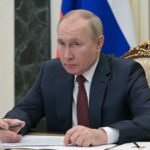Every few years, the U.S. government launches a new initiative to boost economic growth in Africa. In bold letters and with bolder promises, the White House announces that public-private partnerships hold the key to growth on the continent. It pledges to make these partnerships a cornerstone of its Africa policy, but time and again it fails to deliver.
A decade after U.S. President Barack Obama rolled out Power Africa—his attempt to solve Africa’s energy crisis by mobilizing private capital—half of the continent’s sub-Saharan population remains without access to electricity. In 2018, the Trump administration proclaimed that its Prosper Africa initiative would counter China’s debt-trap diplomacy and “expand African access to business finance.” Five years on, Chad, Ethiopia, Ghana, and Zambia are in financial distress and pleading for debt relief from Beijing and other creditors. Yet the Biden administration is once more touting the potential of public-private investment in Africa, organizing high-profile visits and holding leadership summits to prove that this time, the United States really is “all in” on the continent.
There is a reason these efforts have yielded so little: goodwill tours, clever slogans, and a portfolio of G-7 pet projects in Africa do not amount to a sound investment pitch. Potential investors, public and private, need to know which projects in which countries are economically and financially worthwhile. Above all, that requires current and comprehensive data on the expected returns that investment in infrastructure in the developing world can yield. At present, investors lack this information, so they pass. If the United States wants to “build back better” in Africa—to expand access to business finance and encourage countries on the continent to choose sustainable and high-quality foreign investment over predatory lending from China and Russia—it needs to give investors access to better data.
Fortunately, Washington has just the right person for the job: Ajay Banga, the White House’s pick to become the next leader of the World Bank. Banga knows the value of the bank’s vast but underused repository of data. In his past work as the president and CEO of Mastercard, he built public-private partnerships that offered people around the globe better access to the banking system—and he did so by relying on data collected by the World Bank. When Banga takes office on June 2, he should replicate that approach and marshal the bank’s extensive data on developing countries’ electric grids, roads, ports, and railways. Using that data, the World Bank’s experts should estimate the rates of return on potential infrastructure projects and make those estimates available to investors. Doing so would not require so much as an additional nickel from Congress, and it would create the foundation presently lacking for data-driven investments that are profitable, efficient, and sustainable.
BIG CHALLENGES, BIG OPPORTUNITIES
The stakes of U.S. economic policy in Africa are as high as the outlook is challenging. A decade of unproductive loans, a pandemic, and the fallout from the war in Ukraine have left their mark on many African economies. Their governments now face the daunting tasks of improving energy and food security while also reducing dangerously heavy debt burdens. They must accomplish all this even as they try to combat climate change and navigate rising tensions among superpowers vying for the globe’s natural resources.
To meet these challenges, African governments must, among other things, address an acute shortage of infrastructure. Only 43 percent of the continent’s rural population, for instance, has access to an all-weather road. What little reliable infrastructure that exists is coming under further strain as the continent undergoes a demographic explosion. Unlike the graying and shrinking societies of the developed world, Africa is young and rapidly growing. Nigeria’s population, already the seventh largest in the world, is projected to expand by almost three percent per year until 2030.
The upside of that population growth, however, is a booming supply of labor. Add the right combination of power, railways, roads, and ports—plus the right policies and governance structures for using that infrastructure efficiently—and higher economic growth will follow. That growth, in turn, is the most reliable way to reduce debt burdens and increase food security.
As for energy shortages and climate change, the most efficient way to address both concerns is to reduce the amount of energy used per dollar of GDP produced. This, too, requires better infrastructure. Since most GDP is generated in cities, and because the UN forecasts that two billion people, the lion’s share of them Africans, will migrate from rural to urban areas by the end of the decade, building and connecting cities with climate-friendly infrastructure would improve energy security while also helping tackle the climate crisis.
FROM HYPE TO HIGHWAYS
None of this will happen, however, without public-private partnerships that channel rich countries’ capital toward African economies. Multilateral development banks have known this for decades. But their efforts on this front, much like those of successive U.S. administrations, have been characterized by hyperbole and little follow-through. In 2015, when the World Bank launched its own campaign on the issue, in partnership with several other multilateral institutions, it claimed that private investors could alleviate infrastructure shortages, achieve the UN’s Sustainable Development Goals, and make money all at once. The campaign’s “Billions to Trillions” tag line has since also been used by the Biden administration and the G-7.
There has been, however, little to no uptake on the trillion-dollar pitch because prospective investors have had nowhere to turn for reliable and up-to-date information. The only explicit, comprehensive source of estimates of the returns on infrastructure investments in developing countries—specifically, investments in roads and electricity—is a dusty white paper commissioned by the World Bank in the year 2000, based on data from 1985. The bank’s leadership has failed, inexcusably, to update and disseminate these estimates ever since.
The good news is that the World Bank is unwittingly sitting on the necessary information. The returns in its original 2000 white paper were estimated using the bank’s own data. Given his track record of leading with data at Mastercard, Banga is ideally positioned to inspire and drive his new colleagues to produce an updated set of estimates. Once independently vetted and validated, the new estimates should be published in a format that is free, user-friendly, and easily accessible. Governments and private investors, such as pension funds, asset managers, and sovereign wealth funds, could then make better decisions about which projects in Africa—and in the developing world more broadly—are both socially beneficial and privately profitable.
To gather, verify, and disseminate the data is necessary but not sufficient. Stakeholders also need an effective way to parse it—to distinguish those countries in which the World Bank’s threefold promise of better, sustainable, and profitable infrastructure is realistic from those in which it is not. A forthcoming article in the Journal of Economic Literature, co-authored by one of us (Henry), articulates a practical approach by borrowing a concept from Banga’s own corporate finance wheelhouse: the hurdle rate. When deciding whether to invest in a given infrastructure project, corporate investors assess whether the project’s expected return exceeds the return they could earn by investing their money elsewhere, such as the stock market. If it clears that hurdle, so to speak, then investing makes sense.
Investment in a public infrastructure project in a poor country has two hurdles to clear: the expected return must exceed stock market returns both within the same country and in the rich countries from which the financing would flow. Only if a given project clears both hurdle rates will investing private savings from a rich country be profitable and socially worthwhile.
Applying the dual-hurdle test to the World Bank’s existing 1985 data reveals a sobering reality. Contrary to the common refrain that poor countries abound with efficient and profitable infrastructure investment opportunities, only seven of the 53 states included in the bank’s white paper cleared the two hurdles for both roads and electricity. There were, however, 21 countries that cleared both hurdles for roads. And in those 21 countries, the average return on roads was ten times higher than the average return on private capital in rich countries. Moreover, the extreme shortage of infrastructure that persists in the developing world—along with improvements in economic policies and governance since 1985—suggests that returns could be even higher today. But without updating the data and the estimates, it is impossible to know.
BUILDING BACK BETTER
Free, user-friendly data on expected infrastructure returns would empower all the relevant stakeholders. African leaders could prioritize infrastructure projects with the best prospects for driving economic growth. Private investors could choose which infrastructure projects to finance. And members of African civil society could hold their leaders accountable if those leaders choose to pursue projects that are not economically sound.
Getting this right is critical. How—and how quickly—the infrastructure problem is addressed has existential ramifications for rich and developing nations alike. Without efficient, climate-friendly infrastructure, the demographic and rural–urban shifts in Africa will lead to overcrowding and accelerating carbon dioxide emissions. Without infrastructure as a solid foundation for growth, governments in the region will struggle to generate jobs for their growing populations, driving an ever-greater exodus, through legal and other channels, of workers to the United States and other rich countries. Lending to the wrong projects will send vulnerable countries further down a path of default, leaving both Africa and the global economy worse off.
Banga will have his work cut out for him at the World Bank. But the institution’s new leader has a chance to unleash market financing for ecologically sound infrastructure that generates inclusive growth, averts Africa’s looming debt crisis, slows climate change, and curbs China’s hegemony. The bridge Banga can build—from slogans to a data-driven reality—is one that is truly worth building.
Source : Foreign Affairs















